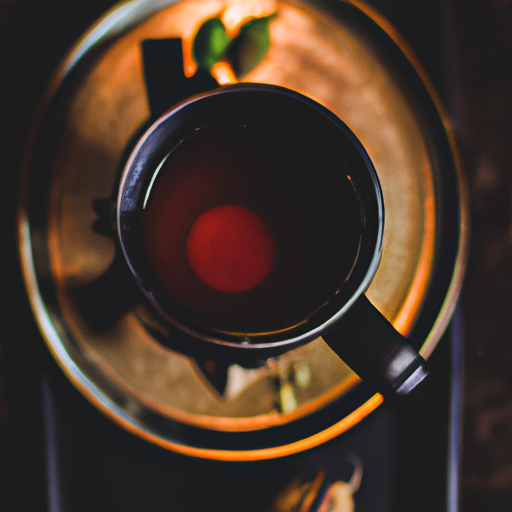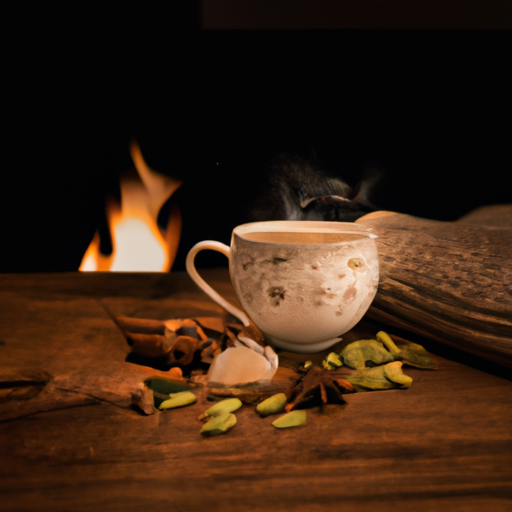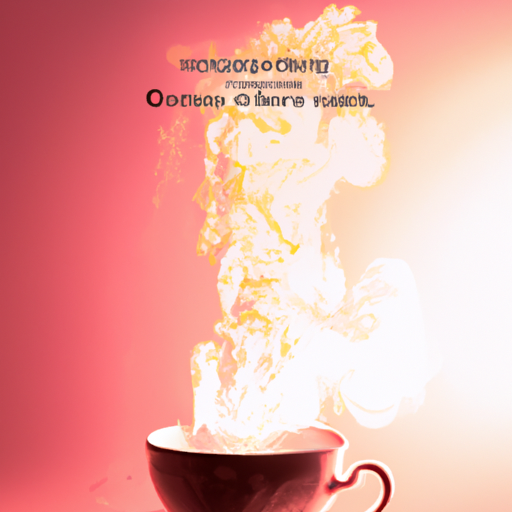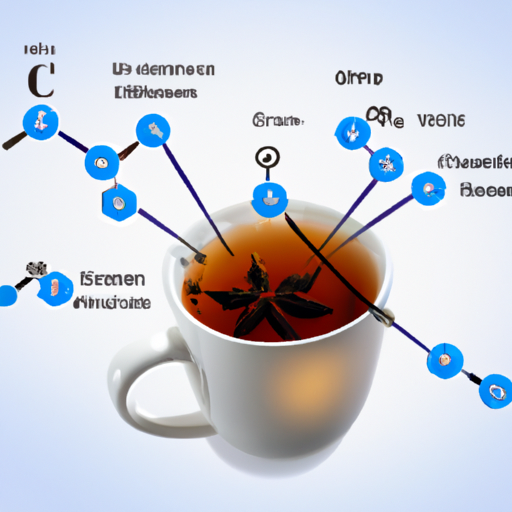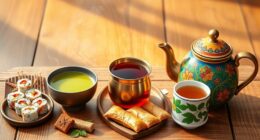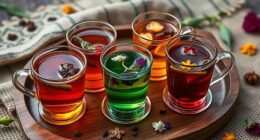As someone crazy about tea, I’ve always been curious about what color chai really is. Is it like rich chocolate, fiery sunset, or golden sunlight? Turns out, it’s not that straightforward.
Chai tea can come in a variety of colors depending on its ingredients and preparation method. To understand the color of chai tea, we must first explore its history and ingredients.
Chai tea originated in India and is traditionally made with black tea, milk, spices such as cinnamon and cardamom, and sweetener such as honey or sugar. However, there are many variations of chai tea that use different types of teas (such as green or rooibos) and additional ingredients (such as ginger or cloves).
Each ingredient can contribute to the overall color of the final brew. In this article, we will delve into the nuances of chai tea’s color and what factors influence it.
Key Takeaways
- The color of chai tea can vary greatly depending on its ingredients and preparation method.
- Traditional chai tea is made with black tea, milk, spices, and sweetener.
- Different regions in India have their own unique variations on the recipe.
- Chai tea can be paired with both sweet pastries and savory snacks.
History of Chai Tea
Did you know that the history of chai tea dates back thousands of years? The origins of this aromatic beverage can be traced back to ancient India, where it was known as ‘masala chai.’
In India, chai is more than just a drink – it has cultural significance and is often served as a symbol of hospitality and friendship.
The traditional method of preparing masala chai involved brewing black tea with a blend of spices such as cinnamon, cardamom, ginger, cloves, and pepper. This spicy concoction was believed to have medicinal properties and was used to treat various ailments.
Over time, different regions in India developed their own unique variations on the recipe by adding or substituting ingredients like fennel seeds or nutmeg.
As trade routes expanded throughout Asia and Europe, so too did the popularity of masala chai. Today, chai tea has become a beloved beverage around the world for its rich flavor and health benefits.
But what exactly goes into making this delicious drink? Let’s take a closer look at the ingredients in chai tea.
Ingredients in Chai Tea
You’ll find that the combination of black tea, ginger, cinnamon, cardamom, and cloves in this spicy drink accounts for its popularity among many coffee shops. These spices lend a warm and comforting flavor to the drink that is perfect for colder weather or as a pick-me-up.
To brew chai tea, you start by steeping black tea leaves in hot water before adding in the spices and simmering everything together. The brewing process is essential to creating the perfect cup of chai tea. The longer you simmer the ingredients together, the more flavorful and aromatic your chai will be.
Some people prefer to add milk or honey to their chai for added sweetness or creaminess. Overall, it’s a very customizable drink that can be adjusted to fit your personal tastes.
Moving on to variations in chai tea color, you’ll notice that there isn’t always a uniform answer when it comes to what color chai tea should be. Depending on where you’re ordering it from or how you make it at home, your chai could range from a pale yellow-brown color all the way to a deep reddish-brown hue.
Ultimately though, regardless of its color, one thing remains constant – its delicious taste!
Variations in Chai Tea Color
The hue of chai can vary greatly depending on the preparation method and location of origin, adding depth to the sensory experience. The color intensity of chai tea can range from a light brown to a deep amber shade. This diversity in color is due to differences in brewing time and the type of spices used.
In India, where chai tea originated, it’s common to add more milk than water during preparation. This results in a lighter color and creamier texture. In contrast, regions such as Nepal tend to add more water than milk, leading to a darker and stronger brew. Additionally, some chai teas are made with black tea leaves while others use green or herbal bases which can also affect its color.
Overall, the variations in color highlight the unique characteristics of each style and region’s approach towards preparing this beloved beverage. As we delve deeper into traditional methods of preparing chai tea, we’ll see how these techniques impact not only its appearance but also its taste and aroma.
Traditional Methods of Preparing Chai Tea
To properly prepare a perfect and piping hot cup of spicy chai, one must follow traditional techniques passed down through generations. Here are the steps I use to make my own chai tea:
-
Spice blends: The spices used in chai tea can vary depending on personal preference and regional traditions. However, the most common ingredients include cinnamon, cardamom, ginger, and cloves. These spices are typically ground together into a fine powder.
-
Brewing techniques: To brew the perfect cup of chai tea, start by bringing water to a boil in a small saucepan. Add the spice blend and let it simmer for a few minutes until the aroma is released. Next, add loose leaf black tea or tea bags to the mix and continue to simmer for an additional 3-5 minutes until the flavor has developed.
-
Straining: Once brewed to perfection, strain your chai mixture before adding any additional flavors such as honey or milk. This will remove any leftover chunks of spice that may have made their way into your drink.
These traditional methods produce a deliciously spiced beverage that’s sure to warm you up on even the coldest of days! However, if you’re short on time or prefer something with less caffeine content, there are modern methods available as well which we’ll explore in depth in our next section about preparing chai tea using alternative techniques!
Modern Methods of Preparing Chai Tea
If you’re looking for a quicker and more convenient way to enjoy the rich flavors of spiced chai, there are several modern methods available that can still provide a delicious cup of this beloved beverage. One popular option is a chai tea latte, which combines steamed milk with concentrated chai tea and often includes a touch of sweetener. This can be made at home with store-bought concentrates or using homemade recipes.
Chai tea concentrate is another modern method for preparing chai tea. These concentrates typically include all the necessary spices and flavors in a concentrated liquid form, allowing for easy mixing with hot water or milk. They can be purchased pre-made or created at home by simmering together black tea, spices, and sweetener until reduced into a concentrated syrup.
While these modern methods may not have the same level of authenticity as traditional preparation techniques, they offer convenience without sacrificing flavor. Additionally, many people appreciate being able to customize their chai tea to their own preferences by adjusting the amount of spice or sweetness added.
Overall, whether you prefer a classic preparation or one of these newer options, there’s no denying that chai tea is an enjoyable and flavorful beverage with numerous health benefits.
Next up, let’s talk about those health benefits!
Health Benefits of Chai Tea
You’ll be pleased to know that indulging in a cup of spiced chai can provide you with numerous health benefits. The spice blends used in chai tea have been shown to boost the immune system, reduce inflammation, and aid in digestion. Additionally, the caffeine content in chai tea can help improve mental clarity and focus.
The spice blend used in chai tea typically includes cinnamon, cardamom, ginger, cloves, and black pepper. These spices are known for their anti-inflammatory properties and ability to boost the immune system. Ginger specifically has been shown to aid in digestion by reducing nausea and vomiting.
It’s important to note that while chai tea does contain caffeine, it typically contains less than coffee or traditional black teas. This means that you can enjoy the health benefits of chai without experiencing the jittery side effects often associated with higher caffeine intake.
With all these amazing benefits, it’s no wonder why so many people enjoy a warm cup of spiced chai on a chilly day!
As we transition into discussing the flavor profile of chai tea, it’s important to note that these health benefits do not come at the expense of taste. In fact, the spice blend used in chai tea creates a complex flavor profile that is both warming and invigorating.
Flavor Profile of Chai Tea
Indulging in a warm cup of spiced chai can transport your taste buds to a world of bold and exciting flavors. The intricate spice blends create an explosion of tastes that dance on your tongue, leaving you craving another sip.
Some popular spices found in chai tea include cinnamon, cardamom, ginger, cloves, and black pepper. Each ingredient adds its unique flavor profile to the mix, resulting in a warming and invigorating beverage.
Milk options also play a vital role in enhancing the flavor of chai tea. Whole milk is commonly used for traditional recipes because it creates a creamy texture that balances out the spices’ heat. However, plant-based alternatives such as almond milk or coconut milk are becoming increasingly popular due to dietary restrictions or personal preferences. These options provide different levels of sweetness and add their distinct nutty undertones to the drink.
To enjoy the full potential of this aromatic beverage, try pairing it with complementary foods like pastries or savory dishes. The richness of chai tea pairs perfectly with sweet treats like donuts or muffins, while its spiciness complements savory snacks such as samosas or roasted nuts.
The possibilities are endless when it comes to pairing chai tea with food; experiment with different combinations until you find your favorite match!
Pairing Chai Tea with Food
Savoring a warm cup of spiced chai is like taking your taste buds on a flavorful journey, especially when paired with sweet pastries or savory snacks. The bold and complex flavors in chai tea make it the perfect beverage to pair with food.
For spicy snacks, try pairing your chai tea with samosas or spiced nuts. The heat from the snack will complement the spices in your tea, creating a harmonious balance of flavors.
If you have a sweet tooth, pairing your chai tea with sweet treats is always a good idea. Sipping on this warm and comforting beverage while nibbling on shortbread cookies or pumpkin bread will create an explosion of deliciousness in your mouth. The sweetness from your treats will help to mellow out the bold spices in your tea, making for an unforgettable culinary experience.
Now that we’ve explored some tasty food pairings for chai tea, let’s move onto popular recipes that incorporate this beloved beverage into their ingredients list. From lattes to smoothies, there are endless ways to enjoy the rich and spicy flavor of chai tea beyond just sipping it straight up.
Popular Chai Tea Recipes
I hope you enjoyed learning about the best food pairings with chai tea in our previous subtopic. Now, let’s dive into some of the most popular recipes that incorporate this delicious and aromatic drink.
-
Chai Latte: This classic recipe is a staple for any chai lover. Simply brew your favorite blend of chai tea and mix it with steamed milk and honey or sugar for sweetness.
-
Spiced Chai Smoothie: Blend together chai tea, banana, cinnamon, vanilla extract, and your choice of dairy alternative for a healthy and flavorful breakfast or snack.
-
Chai Spice Cake: Add spice blends like cardamom, cinnamon, ginger, and cloves to your favorite cake recipe to create a warm and cozy dessert perfect for fall.
-
Dirty Chai Cocktail: Mix espresso shots with brewed chai tea and spiced rum or whiskey for a boozy twist on the traditional latte.
When it comes to making these recipes at home, don’t be afraid to experiment with different spice blends or dairy alternatives to find the perfect combination that suits your taste buds. Whether you prefer creamy coconut milk or almond milk in your latte or want to add extra ginger or nutmeg to your cake batter, there are endless ways to make these recipes uniquely yours.
So go ahead, grab a bag of your favorite chai tea blend and get creative in the kitchen! These recipes are sure to impress friends and family alike with their rich flavors and comforting aromas.
Frequently Asked Questions
What are the origins of the name "chai"and how did it become associated with tea?
When it comes to the origins of the name ‘chai’ and its association with tea, there is a rich history to explore. The etymology of ‘chai’ can be traced back to the Persian word for tea, ‘chay’, which spread throughout Central Asia and eventually made its way into India.
In India, ‘chai’ became a cultural staple, often served as a spiced milk tea that was enjoyed by people from all walks of life. The cultural significance of chai cannot be overstated – it is a drink that is deeply ingrained in Indian culture and has become an important symbol of hospitality and community.
Today, chai tea has become increasingly popular around the world, with many variations on the traditional recipe available. Regardless of how you take your chai, one thing remains clear: this iconic beverage will always have an important place in our hearts (and our mugs).
Are there any cultural or religious traditions surrounding the drinking of chai tea?
As an avid chai tea drinker, I can attest to the fact that there are indeed cultural and religious traditions surrounding its consumption.
In India, for example, chai is often served as part of tea ceremonies which hold great social significance.
Additionally, certain religions such as Sikhism view the sharing of food and drink as a way to promote equality and unity among all people.
As for health benefits, chai has been shown to aid in digestion, boost immunity, and even lower cholesterol levels due to its blend of spices such as ginger and cinnamon.
While many may simply enjoy chai for its delicious taste, it’s clear that there are deeper meanings behind this beloved beverage.
Can chai tea be made with different types of tea leaves, and if so, how does that affect the flavor and color?
Let me tell you, the variety of chai tea out there is mind-boggling! Different tea leaves can be used to make chai, and each one brings its own unique flavor and color to the mix.
For example, black tea leaves are commonly used for a rich, strong brew that pairs well with spices like cinnamon and cardamom. On the other hand, green tea leaves can give a lighter, more delicate flavor that highlights the sweetness of honey or vanilla. And if you really want to get adventurous, you can try using white or oolong tea leaves for even more flavor/color variations!
Of course, brewing techniques also play a big role in how your chai turns out – do you use milk or water? How long do you steep? But no matter what combination of ingredients and methods you choose, I guarantee that any cup of chai is sure to be deliciously complex and satisfying.
How does the brewing method affect the color and taste of chai tea?
When it comes to brewing variations, the method used can definitely affect the flavor and color of chai tea. For example, some recipes call for boiling the tea leaves with spices and milk, while others suggest steeping the leaves in hot water before adding milk and spices.
The former method tends to produce a darker, richer color due to prolonged exposure to heat, while the latter may result in a lighter hue. Additionally, spice blends can also impact both taste and appearance – using more cinnamon or cardamom may create a deeper brownish-red tint compared to a blend with less of those particular spices.
Ultimately, experimentation is key when finding your preferred brewing style and spice combination for chai tea.
Are there any common misconceptions about the color or flavor of chai tea?
Color misconceptions and flavor variations are two common misunderstandings surrounding chai tea. It’s ironic how people often assume that the color of chai tea reflects its taste, when in reality, the brewing method plays a bigger role in determining both aspects.
Some may think that a darker colored chai will be stronger or more flavorful, but this is not necessarily true. Similarly, there are many variations in the ingredients used to make chai tea, which can affect its flavor profile greatly. From sweet to spicy to creamy, there’s no one definitive taste for chai.
So while it’s easy to get caught up in assumptions about the color and flavor of this beloved beverage, it’s important to remember that every cup of chai is unique and should be enjoyed for what it is – a delicious and complex blend of spices and flavors.
Conclusion
Well folks, that’s a wrap on the topic of what color chai tea is. As we’ve learned, the color of chai tea can vary depending on the ingredients used and preparation methods.
From a warm golden brown to a rich reddish hue, each cup of chai tea can be as unique as its drinker. But beyond its appearance, chai tea offers a plethora of health benefits and an intricate flavor profile that pairs well with many foods.
So next time you brew up a cup of this delicious beverage, take a moment to appreciate not only its color but also all that it has to offer. As they say, "a picture is worth a thousand words,"and in this case, every sip of chai tea paints a beautiful picture for our senses to enjoy.

